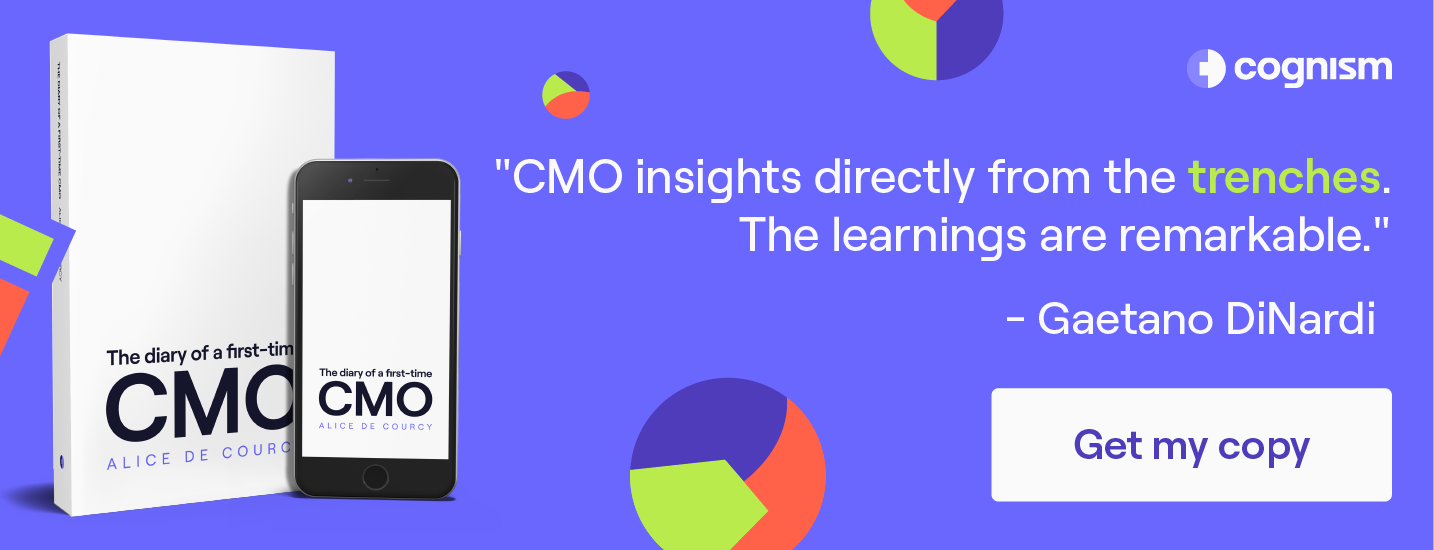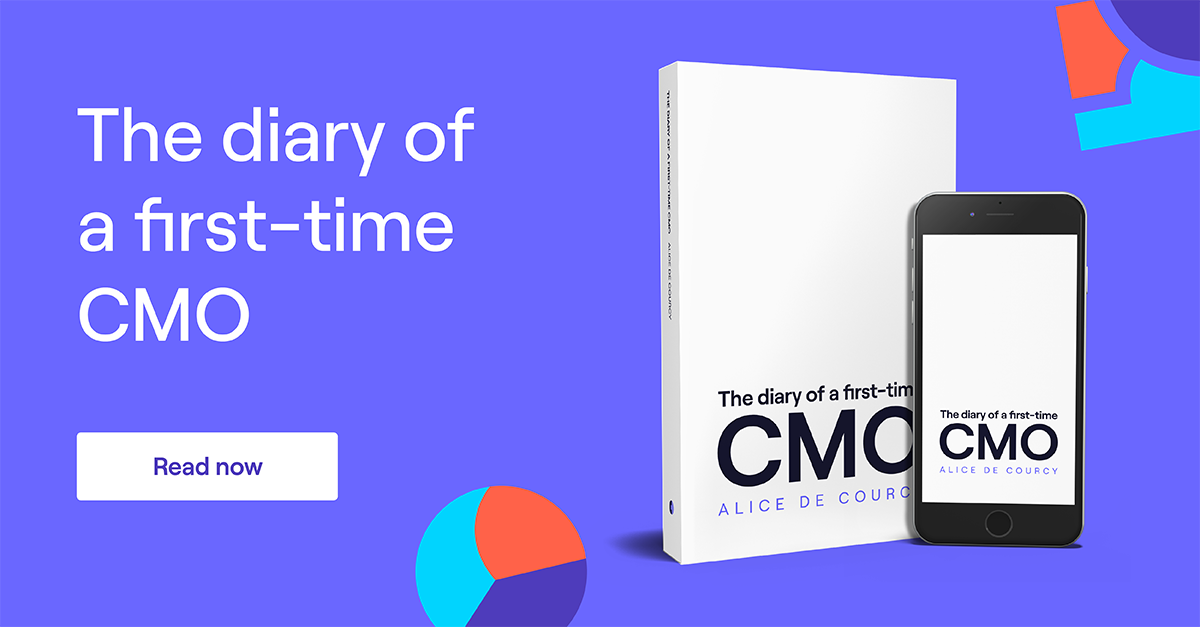The Ultimate Demand Gen FAQ List
What's on this page:
Over the last few years, Cognism's marketing team has made the switch from lead generation to demand generation with great success.
Our journey has been well documented, and spearheaded by CMO, Alice de Courcy. As a result, we’ve received a lot of questions from interested marketers.
On this page, we aim to provide answers to (most!) all of the demand generation questions our followers have. We hope this makes things easier for any marketers looking to make similar changes.
Use the menu to the left to find a specific question, or search using Command + F.
How can someone become a lead if you've ungated everything?
Demand generation comes with a shift in focus. We’re focused on acquiring leads when they’re ready, rather than when we feel they’re ready.
So, instead of taking contact info via gated resources, we provide demo request forms and 'contact us' forms for when our audience is ready.
This means we get fewer leads, but they convert at a much higher rate. The leads who are completing our demo forms have more buyer intent. This means that less sales time is wasted chasing low-quality leads.
We discovered this by splitting the funnel. Measuring the conversion rates of direct inbound leads and MQLs separately. We found that 1 in every 25 direct inbound leads converted, whereas 1 in every 500 MQLs converted.
These statistics won’t be the same for every company, so split the funnel and try it for yourself!
Press play below ▶️ to find out more about ungated content from Alice de Courcy.
How do you measure demand generation success before the demo requests start coming in?
When generating demand you can divide your reporting in two, looking at:
Focus on engagement, knowing that the people who are positively engaging are building awareness and learning about you. This will help build demand and increase their propensity to submit a demo when the time is right.
You can measure engagement using metrics: such as Impressions, reach, likes, shares, comments, reactions, CTR, scroll depth, time on page, bounce rate, video views etc.
If these are on the up, your conversion metrics will soon follow.
Whilst the main metrics you focus on will vary depending on your goals and focus channels, they should always be made up of:
- Platform metrics
- Qualitative feedback
- Influence on pipeline
- Gut feeling
For paid social, how do you measure success without MQLs?
Really it depends on what you’re using paid social for. You have to define your goals before you can define how you’ll measure success.
If you’re using it for demand creation, the goal is to be heard. You’ll want to measure engagement metrics such as: impressions, reach, likes, shares, comments, reactions, CTR, scroll depth, time on page, bounce rate, video views etc.
If you’re using it for demand capture, with retargeting campaigns or intent data. You’re going to be focused on conversion metrics, such as CPL, CTR and number of demos.
What are the most successful ad channels?
This will vary depending on where your audience hangs out. Using the metrics from the question above (depending on your goals), run some tests on these sites and see which ones give you the best results.
We’ve found great results for demand creation and demand capture on Facebook and LinkedIn, but our main channel for demand capture is Google Ads. In Google Ads, we find it easiest to reach a high-intent audience.
Do you need a big budget to do testing with paid ads, audiences and retargeting?
In short, no. We started with a relatively small budget for experimenting. Just 2% of our overall marketing budget. Then we ungated content resources that weren’t performing well and measured the results. This was an inexpensive task.
The trick with small budgets is to avoid spreading yourself too thin. If you’re working with a small initial budget, be focused with your intended reach and audience size.
Running too many large-scale campaigns won’t give you reliable results to determine accurately whether your campaigns have been successful.
How do you convince stakeholders to invest in a demand generation model?
Stakeholders are more likely to invest in proven results than convincing theories. Knowing this, we used our small initial budget to run tests and gather results. Then, we split the funnel. We gathered data on the conversion rates from inbound DG leads, and MQLs.
We were able to show a huge discrepancy between the number of DG leads converting, and the number of LG leads converting.
Find out more about this from our CMO, Alice in her diary entry.
Who creates the content for a demand generation marketing team? Is it in-house or outsourced?
This really depends on your budget. It’s not always possible to have in-house content creators.
If possible, we do recommend having in-house content creation. But, if you are using a freelancer, it’s important to find someone who fully understands the purpose of your content and knows your target audience.
How do you balance building a long-term demand generation structure with achieving short-term goals?
If you’re switching from a lead gen to a demand gen model, you have to be realistic. You’re not going to see DG results overnight.
In the beginning, we continued to run our existing lead gen strategy until our DG machine was powerful enough to take over. We'd recommend you do the same.
Lead gen provided the short-term results we needed for revenue, while we worked on a long-term demand gen model.
If you’re going ahead with a pure DG model, you’ll need all elements of the DG picture working perfectly.
That means consistent work on capturing current demand, while you work on building new campaigns to capture all possible demand.
The worst thing you can do is set and forget DG campaigns. Your audience will grow tired of the messaging and creatives, and results will drop off.
When you have high-performing campaigns, monitor them closely. These will provide the short-term results while you design a long-term structure.
If you’re struggling for short-term results (maybe you’ve moved into DG a bit too quickly), focus on high-performance channels. If LinkedIn ads are giving you great results, allocate more spend there. When pipeline is looking strong, give more budget to more experimental channels.
How does content marketing operate in a demand generation model?
Demand generation isn’t the death of content. Quite the opposite. Content is a powerful tool in demand generation, because it provides the value that drives demand.
The key difference is a switch in purpose. The main goal of your content becomes to provide value, in-feed and on-site. Whereas previous content was aimed at creating long-form gated pieces to generate leads.
This switch in focus means a switch in roles. Split your content creators into those who stick to an SEO plan, and those focussed on creating 'journalistic content'.
SEO is still important, but journalistic writers can write about exciting, current topics and create expert-led content. As your audience grows, this is the content that demonstrates your expertise and drives demand.
Are trade shows still relevant in a demand generation marketing model?
As with other channels, in a demand gen marketing model trade shows aren’t about generating leads, they’re about driving demand.
How useful are trade shows for demand marketing? Not very.
The main value is content creation. By attending live events, doing live presentations and interviewing experts etc. ... You can create compelling content for your digital channels.
The opportunity cost of trade shows is relatively high. The budget could be well allocated to drive demand online. So, we’d recommend these when you have excess budget and are maxing out your digital channels.
And always, make sure you’re taking the value away from the event and putting it on your digital channels. This is where you can see the best results.
When moving from a lead generation to a demand generation model, should you ungate all of your gated content in one go?
Probably not. We wouldn’t advise any marketing team to go ‘cold turkey’ on lead generation. Start ungated the resources that aren’t performing as well, but keep the ‘big-hitters’ to generate leads while you experiment with DG.
There’s no shame in caution.
Want more tips for ungating content? Listen to Cognism's marketing leaders on how to build a media machine for B2B! ⬇️
What demand generation attribution do we do to know what is and isn't working?
With demand generation attribution, there’s no single source of truth. But, you can build a model that gives you a pretty good picture of the buyer journey.
The first thing to acknowledge is how complicated buyer journeys are. There are stages we’ll never be able to see (the dark funnel), and complicated paths that don’t fit a marketers expectation of what a buyer journey should look like.
In short, people can’t be assigned to a ‘funnel’ and be expected to tumble straight down it.
We have a ‘U shaped’ demand attribution model, measuring the first and last touch. So we can see the first and last touch UTMs, as well as the first and last touch Salesforce campaigns. Knowing this can only tell you so much. So we also record ‘self reported attribution’, which is a form asking ‘how did you hear about us’.
We also track engagement on the platform. Someone might see a Facebook ad, for example, and come inbound directly three weeks later.
How do you distribute the blog in a demand generation marketing team?
The demand generation content motto should be ‘lead with value’.
Everything has to be value driven. This means avoid promoting content with your organic social media. Instead, use it to provide value to your intended customer.
So, how do you get eyes on your content?
Organic search (SEO), paid social, and on-site.
Without gated content, the blog isn’t the mouse trap, it’s the cheese. Distribute content only when it provides direct value. And since you’re not using content to capture leads, it only makes sense to share it when it provides value anyway.
Unique page views are useless (or even harmful) when they don’t give the consumer a positive experience.
For how long should you run demand generation ads?
Listen to the metrics. There’s no specific time an ad should run, but the metrics will tell you when it’s time for a refresh.
Eventually your ads will suffer creative fatigue, when your audiences starts getting bored of them. You’ll see this in the statistics and it’ll be time for an update.
We’ve found this happens at around six to eight weeks. But this will vary depending on your audience and market saturation.
How can you run demand generation ads to cold, top of the funnel audiences?
With a demand generation model, it’s important to stop viewing the buyer journey as a funnel. The buyer journey is less predictable than that. For that reason, we no longer display specific content to a specific audience depending on where they are in the buyer journey.
All content goes to the entire audience.
How do you use a subject matter expert in a demand generation model?
We’ve worked with subject matter experts before to bring authority to our content.
A demand generation marketing model depends on high-quality content. You have to create content that excites your audience, and positions you as a valuable and authoritative resource.
Consider bringing in a subject matter expert, like an influencer in your market, either on a part-time or full-time basis. There are two benefits to this:
- You’ll be able to fuel your content and ads with their expertise. Their cutting edge knowledge can form your cutting edge opinions.
- You’ll have access to their existing follower-base. If you can find an expert with a large audience, and encourage them to share the content they’re involved in, you’ll gain followers from their audience.
If this isn’t an option, try to involve experts in your content on a one-off basis by inviting them on a webinar or blog. Then repurpose this content and turn it into useful ads/branch-off content pieces.
Click below for subject matter expert Ryan Reisert's tips on the biggest mistakes sales reps make. ⬇️
Where does design fit into a demand generation marketing team? In-house or outsourced?
Again this will depend on your budget. But we'd recommend either creating branded graphics in-house, or handled by a trusted freelancer.
For more creative briefs, such as a short-term demand gen campaign, these can be outsourced. That's because they don't have to fit specific branding parameters.
This gives you the opportunity to vary who you outsource to, depending on their speciality. The benefit? This can add a unique spin to your campaigns.
Have you tested entertaining content like memes and jokes on organic social?
We have, and we didn’t love the results. We found that content like this is good for short-term success. But it wasn't building the brand image we wanted long-term, as an authoritative and helpful resource.
This might not be the case for all DG teams, so you should experiment and consider what you want your brand image to be.
How do you balance being structured with being experimental in a demand generation marketing team?
It’s important to prioritise structure. Reliable results have to be there before you can experiment with new channels. They provide the budget to experiment.
That said, we don’t believe in undertaking marketing tasks because it’s ‘what we do’. Once the results are in, take time to experiment. Research possible ideas, come up with theories, experiment when one of these theories looks positive.
To which channel do you move promotional posts once you've made organic social 'value only'?
Promotional posts exist on paid channels only. And even there, we aim to provide value with every post. Consumers resent click-bait and cliffhanger content, and so do we.
When we want to promote something on paid socials, it always comes with useful information or a valuable video.
People won’t follow your link because you ask them nicely. The value has to come first.
CMO Secrets Uncovered.
Did you hear our Demand Gen team have leaked Alice's CMO diary...😱
Here's 200 pages of actionable plays and insights that documents Alice's whole journey as a first time CMO which includes the big switch from a lead gen model to a scaled up demand gen approach.
Get unrestricted access right here 👇



